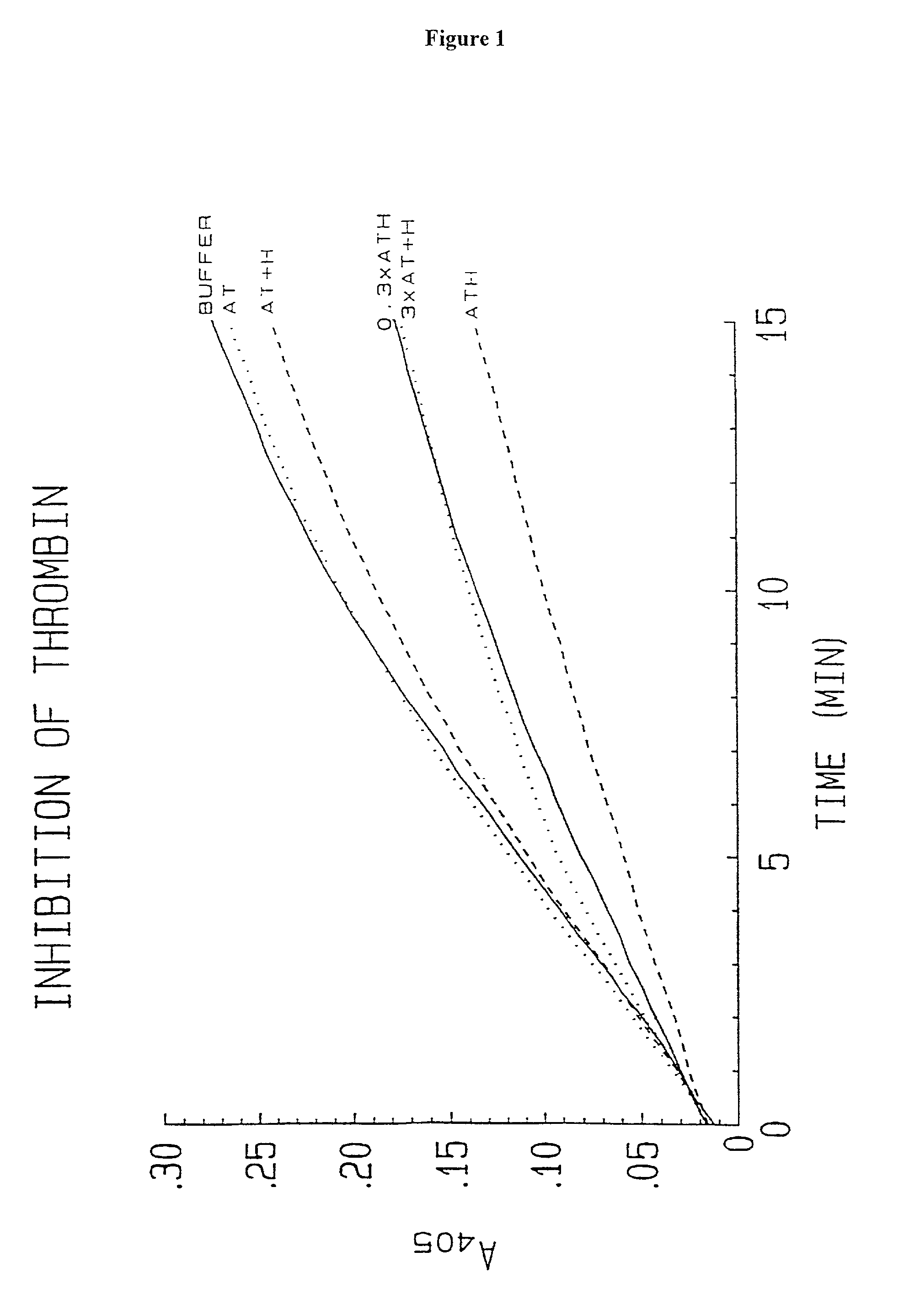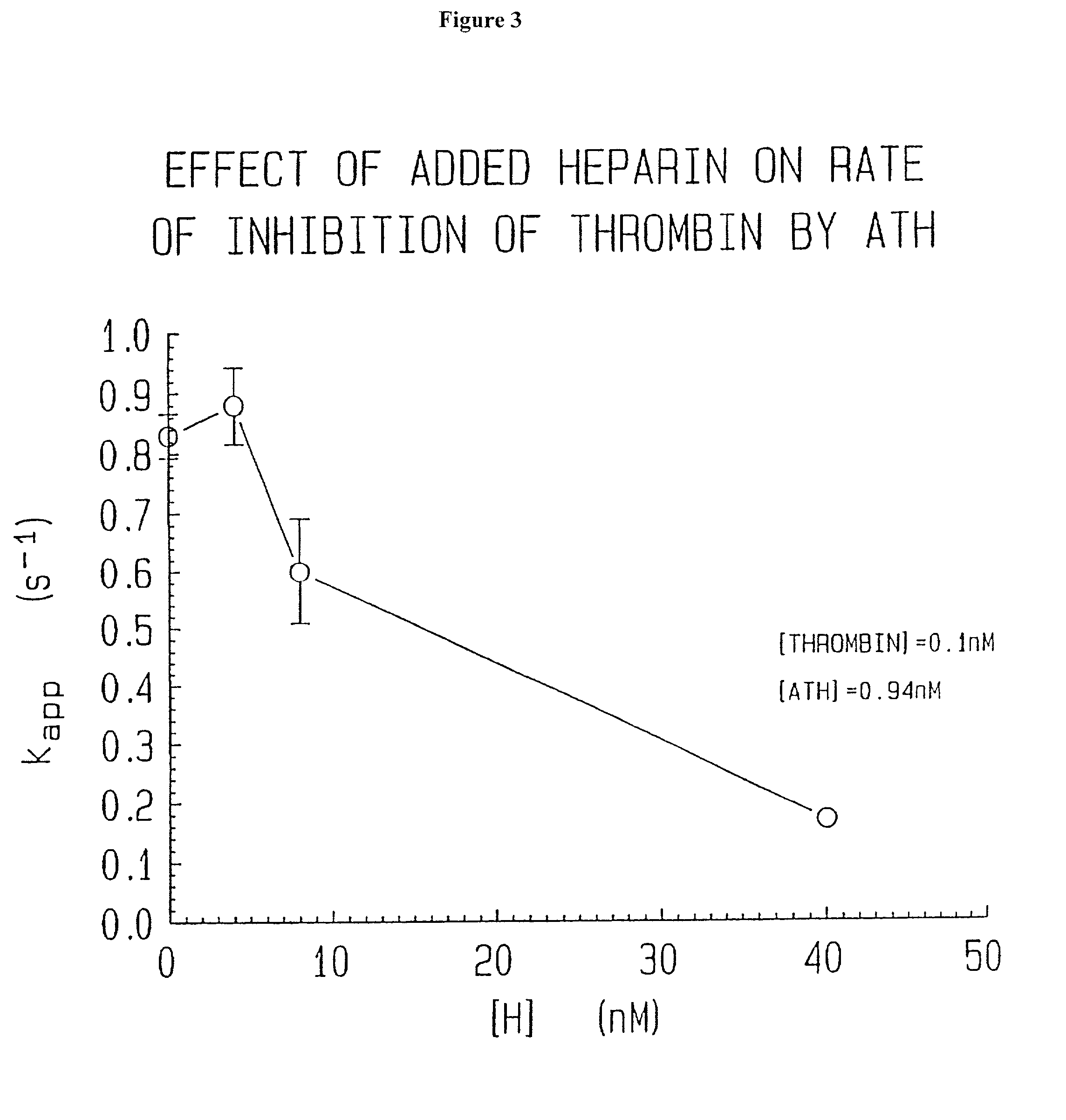Methods of coating a device using anti-thrombin heparin
a technology of thrombin and heparin, which is applied in the field of new chemical compounds, can solve the problems of reducing biological activity and suffering from the same problems of conjugates
- Summary
- Abstract
- Description
- Claims
- Application Information
AI Technical Summary
Benefits of technology
Problems solved by technology
Method used
Image
Examples
examples
Materials
[0190]In the following methodology, unless otherwise noted, “Standard heparin” refers to heparin from commercial sources. High affinity heparin is a heparin fraction in which all of the molecules bind to ATIII.
[0191]Heparin was from porcine intestinal mucosa (Sigma Chem Co U.S.A.). Dermatan sulfate was from porcine intestinal mucosa (Mediolanum farmaceutici S.p.A., Italy). ATIII was from human plasma (Bayer Inc.) HCII was from human plasma (Affinity Biologicals).
example i
Preparation of Covalent Conjugates Between GAGs and Serpins
[0192]Reactions to form covalent complexes between the glycosaminoglycan (GAG) and serpin, for example ATIII or HCII, involved incubation of GAG (5 mg–70 mg) with the serpin (0.5 mg–3 mg) in 1 mL of sterile filtered buffer (0.3M phosphate 1M NaCl, pH 8.0 or 0.02M phosphate 0.15M NaCl, pH 7.3) containing 0.5M sodium cyanoborohydride at 35° C. to 45° C., preferably 40° C., in a sealed plastic tube (polycarbonate, polypropylene, etc). Omitting the sodium cyanoborohydride allowed formation of covalent complexes via Amadori rearrangement which could be radiolabeled by later addition of tritium labelled sodium borohydride. Incubation times ranged from 3 days to 2 weeks. Purification of the covalent product was achieved by a variety of methods. Purification procedures are described in U.S. Pat. No. 5,308,617, U.S. Pat. No. 4,623,718 and FEBS Letters 143(1):96–100, 1982, all incorporated by reference. Gel filtration on Sephadex G-20...
example ii
Characterization of GAG-Serpin Conjugates
[0196]Biological Activity. Anti-Xa activity measured by Collen et al. and Bjork et al. for their respective preparations was carried out by (pre)incubation of the preparations with Xa followed by determination of residual activity of Xa with S-2222 (N-benzoyl-isoleucyl-glutamyl-glycyl-arginyl-paranitroanilide (from Chromogenix, Sweden)). The percent of conjugate molecules with activity (as determined by amount of Xa inhibited) is reported in Table 1. Anti-IIa activity was measured for the antithrombin-heparin conjugate of the invention (i.e. ATH) by titration with different amounts of IIa (thrombin). The amount of IIa inhibited by a given mass concentration of ATH (mass determined by analysis using unmodified starting heparin) was determined by measuring residual activity against S-2238 (D-phenylalanyl-pipecolyl-arginyl-paranitroanilide (from Chromogenix, Sweden)).
[0197]Inhibition of Thrombin Activity. The inhibition of the reaction of bovine...
PUM
| Property | Measurement | Unit |
|---|---|---|
| molar ratio | aaaaa | aaaaa |
| temperature | aaaaa | aaaaa |
| temperature | aaaaa | aaaaa |
Abstract
Description
Claims
Application Information
 Login to View More
Login to View More - R&D
- Intellectual Property
- Life Sciences
- Materials
- Tech Scout
- Unparalleled Data Quality
- Higher Quality Content
- 60% Fewer Hallucinations
Browse by: Latest US Patents, China's latest patents, Technical Efficacy Thesaurus, Application Domain, Technology Topic, Popular Technical Reports.
© 2025 PatSnap. All rights reserved.Legal|Privacy policy|Modern Slavery Act Transparency Statement|Sitemap|About US| Contact US: help@patsnap.com



